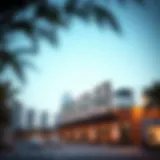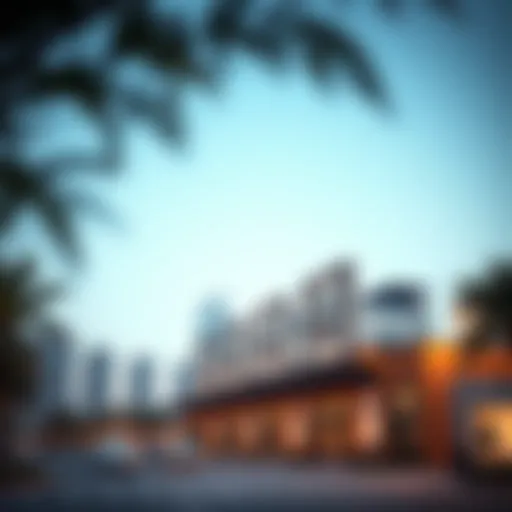Exploring Palladian Properties in Dubai's Market
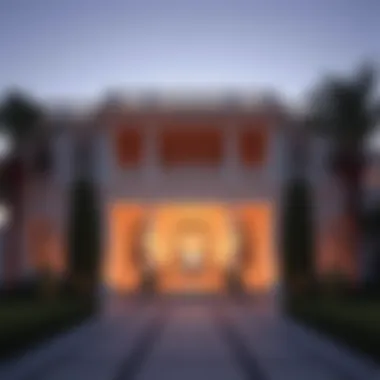

Intro
In recent years, Dubai's real estate scene has seen a flurry of architectural marvels that push the boundaries of traditional design. Among these, Palladian properties stand out, capturing the essence of elegance and classical beauty. These properties, shaped by the principles of Renaissance architect Andrea Palladio, relate not only to aesthetics but also to functionality and harmony with the environment. This exploration provides a comprehensive overview of the Palladian style within the context of Dubai's vibrant real estate market, examining how it shapes investment opportunities for sophisticated buyers and investors alike.
Market Insights
Current Trends in Dubai Real Estate
Dubai's real estate market is akin to a chameleon—it adapts and changes with the times. Over the past few years, there’s been an increasing interest in architectural styles that offer a unique identity, and Palladian properties fit the bill perfectly. Known for their symmetrical shapes, grand columns, and inviting spaces, these homes not only appeal to those with a taste for the classic but also to investors who understand the lasting value they offer.
- In 2023, reports indicate that there’s been a rise of 15% in the sale of luxury properties compared to previous years. Palladian homes, with their timeless charm, are a significant part of this surge.
- Additionally, as more expatriates make Dubai their home, the demand for aesthetically pleasing options has only intensified.
Impact of Economic Factors on Property Prices
The economic landscape of Dubai has always been intertwined with its property prices. Factors such as oil prices, tourism rates, and economic diversification initiatives directly influence the housing market.
For instance, a boom in tourism creates a demand for high-end rentals, boosting the value of Palladian properties in sought-after neighborhoods. The attractive return on investment (ROI) draws in foreign investors too, eager to capitalize on Dubai's stature as a global city.
"Understanding the economic nuances of Dubai’s market is crucial for anyone looking to invest wisely in real estate.”
Investment Opportunities
Best Neighborhoods for Investment
When diving into the world of Palladian properties, certain neighborhoods stand out as hotspots for potential investments:
- Jumeirah: Known for its luxurious lifestyle, Jumeirah boasts several high-end Palladian-style homes with stunning vistas.
- Emirates Hills: This affluent community features properties that blend classical Italian architecture with modern amenities, appealing to elite buyers.
- Dubai Hills Estate: A burgeoning neighborhood with ample green spaces, it’s home to developments that embrace the Palladian aesthetic.
Emerging Real Estate Projects in Dubai
Investors should keep an eye on several projects reflecting Palladian principles:
- The Royal Atlantis Resort and Residences: Combining luxury and design, the architecture draws from the Palladian ethos.
- Binghatti Gardens: A modern take on classic influences, aiming to marry lush landscaping with grand architectural dimensions.
As the landscape of Dubai continues to evolve, being informed about ongoing projects can provide strategic advantages for investors.
As one navigates through the intricacies of this architectural style and its implications on the real estate market, it becomes clear that opportunities abound for those keen on investing in the unique allure of Palladian properties.
Overview of Palladian Architecture
Palladian architecture stands as a testament to the enduring power of classical design. Its significance in the context of Dubai's real estate market cannot be underestimated. With its roots tracing back to the works of Andrea Palladio in the 16th century, this architectural style marries beauty with functionality. Investors, homebuyers, and architects alike are drawn to its symmetry and elegance, which juxtaposes the fast-paced modernity of Dubai. Understanding Palladian architecture equips potential buyers with a deeper appreciation of how these properties fit into the diverse tapestry of the city's real estate offerings.
Historical Background
Palladian architecture originated from the Renaissance ideas brought forth by Andrea Palladio in Italy. His work was deeply influenced by ancient Roman structures, emphasizing harmony, proportion, and symmetry. Major landmarks like the Villa Rotonda epitomized his approach, influencing various architectural movements that followed. As the 18th century rolled in, Palladian principles crossed over to Great Britain, reshaping the country’s domestic architecture. The influence of Palladio can even be seen in prominent American buildings, extending its reach across oceans. In a city like Dubai, where architecture ebbs and flows with cultural influences, Palladian structures offer a bridge to the past amidst contemporary designs.
Key Characteristics
The essence of Palladian architecture can be distilled into several key characteristics that stand out distinctly in Dubai's skyline.
Symmetry and Proportion
Symmetry and proportion lie at the heart of Palladian design. This element ensures that buildings are not just visually appealing but also provide a sense of order and stability. The pleasing ratios established in Palladian homes create a visual rhythm that can be both calming and grand. It attracts buyers who appreciate aesthetic harmony in their living or working environments. Additionally, well-proportioned structures tend to stand the test of time, remaining relevant even as architectural tastes evolve. The uniformity in design, however, must be approached carefully; overly strict adherence to historical formats can clash with the vibrancy of Dubai's rapid urban development.
Columns and Porticos
Columns and porticos are another cornerstone of Palladian properties. These architectural features not only serve a functional purpose but also enhance the grandeur of a building. Columns, with their classical orders, bring an immediate sense of elegance and tradition. They act as visual anchors, often framing the main entrance or façade, making the structure approachable while imposing. Porticos add an inviting layer, providing shelter and a transitional space between the exterior and interior. The downside of such elaborate designs is that they require meticulous maintenance, particularly in a climate like Dubai's, where the elements can be tough on architectural finishes.
Use of Classical Elements
The use of classical elements, such as arches and pediments, further enriches Palladian architecture. These features draw from the language of ancient Rome, creating a narrative that connects the present with a storied past. By incorporating these design motifs, structures exude a timeless quality that resonates with discerning buyers looking for more than just a modern cube. While aesthetic charm is undeniable, incorporating classical elements necessitates a deep understanding of craftsmanship, which can sometimes lead to challenges in preservation and restoration.
Influence of Andrea Palladio
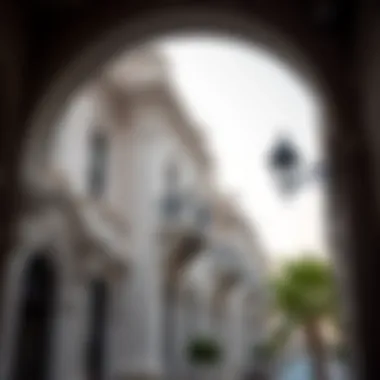

Andrea Palladio's principles remain highly influential, shaping not just architecture but also the aesthetic preferences of individuals today. His attention to detail and the integration of the environment into design sets a benchmark for architects globally. In Dubai, a city that thrives on innovation and bold structures, moving forward with Palladian influences encourages a dialogue between traditional aesthetics and modern needs. This intertwining of old and new provides a unique niche for investors looking to indulge in properties that tell a story while offering luxury living.
Palladian Properties in Dubai
Palladian properties in Dubai are more than just a stylistic choice; they symbolize a blending of timeless architectural elegance with the rapid modernization of one of the world’s most dynamic cities. As investors and homebuyers alike look to this distinctive style, understanding its impact on Dubai’s real estate market becomes critical. In a locale renowned for its juxtaposition of traditional and contemporary designs, Palladian architecture stands as a remarkable testament to what can be achieved when classical principles meet modern innovation.
Benefits of Palladian Properties
The appeal of Palladian properties lies in their sophisticated aesthetics and functional attributes. These properties often feature large, open spaces and harmonious proportions, which can foster a sense of well-being and liveliness. Since homeowners and renters are increasingly drawn towards spacious living quarters that imbue comfort and luxury, these homes can cater to a heightened demand.
Furthermore, Palladian architecture is synonymous with durability. The materials often utilized in these structures—such as limestone and marble—stand the test of time and add to the overall value of the properties. Thus, when potential buyers consider their investment potentials, these are not just residences but assets with enduring worth.
In Dubai's real estate landscape, the combination of aesthetic charm and investment viability makes Palladian properties noteworthy and desirable. As the market swiftly evolves, assessing current trends and notable developments within this segment can provide invaluable insight for discerning buyers and investors.
Current Trends
Currently, the allure of Palladian architecture has gained traction among affluent communities and high-profile developers. A noticeable trend is the merging of traditional Palladian aesthetics with contemporary luxury amenities. This hybrid approach allows for the preservation of unique historical elements while accommodating modern lifestyles. Buyers are increasingly seeking properties that offer both style and comfort, which Palladian designs naturally provide.
The demand, especially in upscale regions of Dubai, also reflects a broader global interest in classic architecture. There’s a renewed appreciation among buyers, who are viewing these properties through both a residential and historical lens.
Notable Developments
Residential Projects
Residential Projects embody the essence of Palladian architecture, often highlighting elegance and spaciousness. A prime example is the majestic villas in Mohammed Bin Rashid City. These residences showcase the hallmark characteristics of Palladian design: symmetrical façades and grand entrances, all while being enveloped within a lush, landscaped environment.
The keystone of these developments is their adaptability—offering potential buyers a family-friendly environment while also serving as luxurious living spaces for professionals. Beyond aesthetics, these projects often include modern smart home technologies, enhancing comfort and functionality.
However, while they present a wealth of benefits, these properties also come with certain disadvantages, such as higher maintenance costs due to the quality materials used, which can deter some potential buyers.
Commercial Spaces
The commercial sectors are witnessing a surge in Palladian-inspired designs too. An outstanding instance can be found in the upscale retail centers designed within the Palladian framework. These spaces not only attract high-end retail brands but also draw in customers through their inviting atmosphere, creating a unique shopping experience.
The key characteristic here is their ability to merge luxury with utility, making them desirable for both tenants and shoppers. However, investing in such locations means facing the pressures of competition in a booming retail market, which might create challenges for businesses not adequately prepared.
Mixed-Use Developments
With an eye on the future, many developers in Dubai are turning their attention to mixed-use developments that incorporate Palladian style. These projects combine residential living, commercial spaces, and entertainment options, all within a single complex, synonymous with urban lifestyles and convenience.
This unique feature not only promotes a community feel but also enhances property value. By being part of a well-rounded development, buyers can find everything they need within walking distance, which is a growing trend among city dwellers today. However, saturation is a potential concern, as numerous mixed-use developments flirt with the same target market, and discerning buyers are likely to become more selective.
Adopting Palladian design principles within these developments signifies a forward-thinking approach while paying homage to architectural heritage. As we move ahead, these properties will likely continue to evolve, reflecting the rich architectural narrative Dubai carries.
Investment Potential of Palladian Properties
Investing in Palladian properties presents a unique opportunity in the vibrant Dubai real estate market. These architectural gems, with their distinct elements rooted in classical design, attract a niche group of discerning buyers and investors who appreciate both aesthetics and historical significance. This section will dive into why such properties hold investment potential, emphasizing key elements, benefits, and considerations that come into play.
Market Demand Analysis
As one looks closer to the market dynamics, the demand for Palladian properties in Dubai is steadily rising. This is influenced by various factors:
- Aesthetic Appeal: Palladian architecture combines elegance with functionality, making it highly desirable among buyers who value both beauty and livability.
- Cultural Significance: In a city known for its modern skyline, the classical roots of Palladian design offer a refreshing alternative, appealing to international investors and residents seeking an iconic architectural style.
- Limited Availability: With relatively few properties embodying this grand style, scarcity certainly enhances their appeal. Buyers are often drawn to the prestige associated with owning a meaningful piece of architectural heritage.
Furthermore, the trend towards hosting events and exhibitions in historic venues within Dubai adds another layer of demand. Investors looking for properties that can serve dual purposes as residences and event spaces may find Palladian homes to be particularly attractive.
Value Appreciation Factors
Understanding the value appreciation of Palladian properties involves several dimensions:
- Location and Urban Development: Properties situated in prime locations often see accelerated appreciation. Dubai is continually evolving, with new infrastructure and urban projects boosting the value of existing properties.
- Quality of Construction: Many Palladian properties are built with high standards and durable materials which contribute to longevity and, consequently, higher resale values.
- Rarity and Design Excellence: The unique aesthetic characteristics and historical significance of Palladian style often lead to an upward trend in property values. In Dubai, where architectural competition is fierce, homes that stand out—like those embodying Palladian principles—are often deemed more valuable.
- Market Sentiment: As the city garners more international attention, the overall real estate market feels the ripple effects. Investors may note that buyer sentiment can substantially increase property values, especially for designs that offer classic charm but within a modern context.
Architectural Integrity and Preservation
Maintaining the architectural integrity of Palladian properties in Dubai is crucial for a variety of reasons. First and foremost, it ensures that the aesthetic essence crafted by Andrea Palladio is not only preserved but also continues to resonate within the contemporary context of Dubai's real estate market. This significance is underscored by the fact that Palladian architecture is characterized by its balanced proportions, grandeur, and classical details, all of which collectively contribute to the city's unique skyline.
The benefits of preserving such architectural integrity go beyond mere aesthetics. They encompass cultural preservation and continuity within the rapidly evolving urban landscape. People invest in Palladian properties not just for their visual appeal, but for the stories they tell—bridging the old with the new. Moreover, understanding these architectural nuances can greatly influence market perceptions and the value of these properties.
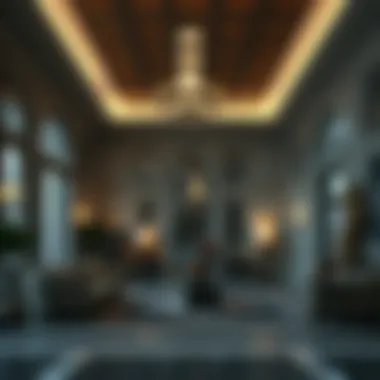

Challenges emerge when attempting to balance modern needs with the preservation of architectural integrity. In a city like Dubai, where skyscrapers depict the advancements in architectural design, restoring and maintaining the character of Palladian properties can feel like trying to fit square pegs in round holes. The juxtaposition of old-world charm and modernism presents a constant tug-of-war.
Challenges in Preservation
The challenges in preserving Palladian architecture in Dubai are multi-faceted. One significant issue is urban development pressures.
- Zoning regulations may favor new construction over preservation, limiting the ability to maintain or restore these historic sites.
- Additionally, financial constraints play a role; renovations can often come with a hefty price tag that some property owners may not be able to shoulder.
- Environmental factors such as the extreme heat and humidity of Dubai also impact the materials used in Palladian architecture, leading to degradation if not properly cared for.
- Another hurdle is community perception. There might be a gap in appreciation for Palladian styles among the newer generations, which influences market demand and investment interest.
These challenges necessitate a strategic approach to preservation.
Restoration Techniques
Restoration techniques aimed at preserving Palladian integrity in Dubai require a deft touch and a clear understanding of original architectural principles.
- Materials Sourcing: Using proper materials that replicate or restore original elements is critical. This might involve sourcing local stone that matches traditional Palladian patterns or importing specific types of wood for accurate finish.
- Modern Technology: Employing 3D scanning and printing can aid in creating replicas of intricate design elements that may have been lost. For instance, if a cornice or column is damaged, technology allows for precise recreations of these classical features without compromising the overall design.
- Adaptive Reuse: This involves modifying existing structures to meet current needs while retaining their historical essence. It might include converting a historic Palladian property into a boutique hotel, effectively serving modern purposes while respecting its architectural legacy.
Restoration not only preserves aesthetics but also enriches the narrative of Dubai as a city that honors its past while looking toward the future. By implementing these effective preservation and restoration techniques, investors and stakeholders are more likely to see value growth in their properties, making these architectural gems not just a tasteful choice but a smart investment.
Understanding and preserving the architectural integrity of Palladian properties is not just about nostalgia—it’s a commitment to the future of real estate in Dubai, blending past grandeur with modern living.
Lifestyle Considerations
In the realm of real estate, the choice of property transcends mere bricks and mortar. It speaks volumes about one’s lifestyle aspirations and value systems. For prospective buyers and investors considering Palladian properties in Dubai, understanding the lifestyle implications becomes pivotal. This architectural style not only provides aesthetic appeal but also influences living experience and community dynamics in numerous ways.
Living in Palladian Properties
Living in a Palladian property is akin to stepping into a timeless narrative. The design principles laid out by Andrea Palladio prioritize harmony and balance, creating spaces that feel both grand and inviting. These homes often feature spacious layouts designed with symmetry in mind, offering an abundance of natural light. Much like a welcoming embrace, the aesthetic charm of arched doorways and precisely aligned columns can inspire feelings of tranquility.
Benefits of Living in Palladian Properties:
- Elegance and Prestige: Residents often find themselves immersed in an atmosphere of sophistication. A home fashioned in this style often signifies status and an appreciation for history, making it a highly desirable option.
- Comfort and Functionality: The thoughtful design integrates seamlessly with modern amenities, ensuring that while the home retains its historical ethos, it remains comfortable and functional for contemporary living.
- Sustainability: Many new constructions echo Palladian principles, focusing on natural materials and sustainable practices. Such choices can provide eco-conscious residents with peace of mind, aligning with their values.
Living in a Palladian property means belonging to a narrative that transcends time, providing a unique blend of historic charm and modern convenience.
Community and Environment
Palladian properties do not merely stand alone; they flourish within their communities. The architectural nature of these homes encourages a certain lifestyle that can foster strong neighborly ties and engagement. Communities surrounding these elegant structures often reflect a commitment to art, culture, and history, appealing to those who prioritize a rich living experience.
Key Elements of Community Life:
- Cultural Enrichment: Residents often participate in local initiatives that celebrate art and heritage, contributing to a vibrant communal atmosphere that enhances daily life.
- Intended Spaces for Interaction: Many Palladian developments include communal areas, parks, or gardens that encourage residents to connect and engage in social activities. These designed environments help nurture relationships, fostering a spirit of camaraderie amongst residents.
- Enhanced Green Spaces: The incorporation of nature into the architectural design promotes a healthier lifestyle. The openness typical in Palladian properties facilitates better air circulation and a connection to outdoor environments, which is seen as increasingly beneficial in urban settings.
"Living in a Palladian property allows individuals not only to enjoy a unique architectural experience but to become part of a larger community that values harmony, aesthetics, and cultural richness."
Comparative Analysis
In the realm of architecture, a comparative analysis serves as a lens through which distinct styles can be understood and appreciated. This section will explore how Palladian architecture holds up against other popular designs, particularly Modern Minimalism and Traditional Arabic Architecture. Understanding these contrasts not only shines a light on the unique features of Palladian properties but also aids investors and buyers in making informed choices.
Palladian vs. Other Architectural Styles
Modern Minimalism
Modern Minimalism has gained traction in many urban locales, including Dubai. One of its central tenets is the notion of ‘less is more,’ which emphasizes simplicity in design. The key characteristic of Modern Minimalism is its clean lines and functional forms that create open spaces free from clutter. This approach is highly beneficial in today’s fast-paced lifestyle.
A standout feature of Modern Minimalism is the integration of natural light. Large windows and open floor plans not only enhance the aesthetic appeal but also promote a sense of connection with the outdoors. However, one of the downsides is that minimalism can sometimes feel sterile or lacking in warmth.
In contrast to Palladian properties, which celebrate classical proportions and intricate details, Modern Minimalism strips these elements away in favor of functionality. This can be a double-edged sword; while clean and straightforward designs are easier to maintain, they may not appeal to those who value architectural storytelling.
Traditional Arabic Architecture
Traditional Arabic Architecture is deeply rooted in the region’s history and cultural heritage. Its main characteristic is the use of intricate geometric patterns, arches, and ornate calligraphy, reflecting the craftsmanship of local artisans. This style is revered for its rich colors and textures, offering a warm, inviting atmosphere.
A unique feature of Traditional Arabic Architecture is the central courtyard concept, which promotes ventilation and privacy in hot climates. This element is advantageous in making homes more comfortable during the scorching Dubai summers.
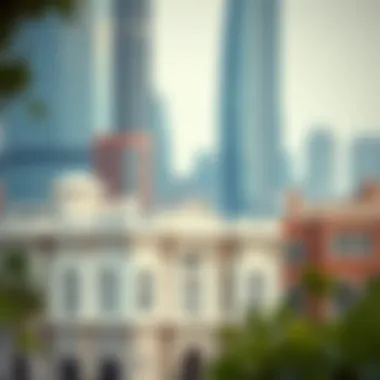

However, when compared to Palladian properties, which emphasize symmetry and open spaces, Traditional Arabic designs can feel more compartmentalized. This can potentially limit the flow within a living space, making it less suitable for certain modern lifestyles that prioritize openness and connectivity.
"Architectural styles are not just aesthetic choices; they are reflections of culture and lifestyle. Understanding these styles is crucial for discerning buyers in Dubai’s real estate market."
For additional insights, check resources such as Wikipedia, Britannica, or engage in discussions on Reddit for a broader perspective.
Future Trends in Palladian Design
The evolution of Palladian design within the realm of Dubai's real estate is truly a fascinating narrative. As the city continues to grow and diversify its architectural landscape, the influences of Palladian principles are being tailored to meet contemporary needs while still respecting historical context. This transformation is not just about aesthetics; it reflects wider societal shifts, technological advancements, and emerging lifestyle preferences.
Innovations in Design
Palladian architecture has traditionally been characterized by symmetry, grandeur, and an adherence to classical elements. However, modern influences are reshaping this style in notable ways. For example, some new developments integrate innovative materials such as reinforced concrete and energy-efficient glass, dramatically changing how spaces are experienced without abandoning their classical roots.
- Sustainable Features: One significant innovation includes eco-friendly building methods, such as utilizing solar panels integrated within the classic rooflines or installing biodiverse green spaces that echo the farms of the Italian countryside. This melding of the old and new not only enhances sustainability but also fosters a harmonious relationship between the home and environment.
- Smart Home Technology: The incorporation of smart home systems is not just a trend; it's a necessity in today's world. Integrated technologies can control lighting, heating, and security systems, thus maintaining the traditional elegance of Palladian style while providing modern conveniences and efficiencies.
- Flexible Spaces: Recent designs are also beginning to reflect a greater emphasis on versatile living spaces that can adapt to residents' changing needs—family gatherings and work-from-home settings have led architects to create open floor plans customized for luxurious comfort without losing structural integrity.
Through these innovations, Palladian properties are not merely about keeping up with global design trends. Instead, they stand as testaments to the adaptability of classic architecture in a rapidly changing world.
Impact on Urban Development
As Dubai marches toward a future where every square meter holds importance, the impact of Palladian design principles on urban development cannot be overstated. The aesthetic richness brought by Palladian buildings contributes to the cultural fabric of the city, creating a unique urban identity amidst the modern skyscrapers and luxury hotels.
- Cultural Symbolism: Palladian properties often evoke a sense of history and timelessness, which can set a benchmark within neighborhoods aiming to establish a sense of prestige and heritage. This aesthetic serves not only existing residents but also attracts international investors and tourists, enhancing the area’s appeal.
- Spatial Efficiency: With careful planning, Palladian designs can help maximize space without feeling cramped. Urban planners are noticing how these properties elevate the environment by balancing low-density residential areas with sprawling green parks, thus fostering community interaction and well-being.
- Economic Stimulus: Moreover, developments that embrace Palladian architecture often see a rise in property values, promoting investment and economic activity in surrounding areas. This effect ripples through the wider economy, as increased demand spurs job creation in construction and related industries.
Through both innovation and adaptation, Palladian architecture continues to find relevance in the urban tapestry of Dubai. Its legacy and future are intertwined in a dance that respects the past, engages the present, and optimistically looks toward the future.
"The beauty of Palladian design is not just in the façade, but in its ability to inspire community and timeless living."
Legal Considerations
The real estate market in Dubai is a treasure trove of opportunities. However, navigating this landscape requires a firm grasp of the legal considerations that influence property ownership, particularly when it comes to Palladian properties. Understanding the legal framework is crucial for investors, homebuyers, and anyone involved in this sector. This section delves into vital aspects such as regulations and zoning laws, which play pivotal roles in the buying and selling of these distinctive architectural gems.
Regulatory Framework
In Dubai, the regulatory framework governing real estate is robust, designed to protect both buyers and sellers. The Dubai Land Department (DLD) oversees real estate transactions, ensuring transparency and fairness. One of the primary benefits of this framework is the clarity it provides. Buyers can feel secure knowing that their investments are safeguarded by established laws.
Several regulations specifically impact Palladian properties, often emphasizing preservation and architectural integrity. For instance, Law No. 7 of 2006 pertains to property development and outlines standards that residential and commercial buildings must meet. Adherence to this law is essential for developers of Palladian properties, as it helps maintain the unique character that makes these buildings so appealing.
Moreover, cooperative associations play a significant role in managing shared properties and maintaining common areas. They ensure that all stakeholders abide by the rules, which can include aspects like renovations or modifications to existing structures. It’s worth noting that familiarizing oneself with the regulations can prevent potential legal troubles down the line.
Zoning Laws and Restrictions
Zoning laws in Dubai dictate how land can be used, and they are essential for maintaining the order and aesthetic desired in various districts, especially those featuring Palladian architecture. These laws govern everything from the height and size of structures to the types of businesses that can operate in certain areas.
Understanding these restrictions can be a double-edged sword. For investors, knowing where Palladian properties can be developed or modified is crucial. For example, certain zones may prohibit residential use in a primarily commercial district, impacting the potential for a property’s appreciation. Buyers should also be aware that any alterations to an existing Palladian property may require additional permits, which can be a hurdle if not anticipated.
In certain areas, especially those with historical significance, stricter regulations are enforced. These rules aim to maintain the city’s cultural heritage by protecting properties from radical changes that could compromise their architectural identity. So, for anyone looking to invest, it's imperative to consult with a legal professional or real estate expert who understands these zoning intricacies.
"Legal knowledge is like a compass; it can guide you through the complexities of the market, ensuring that your investment journey is a smooth one."
In summary, comprehension of the regulatory framework and zoning laws not only shapes the real estate landscape in Dubai but significantly influences the viability of Palladian properties. Engaging with these legal aspects ahead of time ensures that investors can make informed decisions, protecting their investments and enhancing potential returns in this ever-evolving market.
Finale
In this intricate exploration of Palladian properties within Dubai's vibrant real estate market, it's imperative to recognize the multifaceted significance of the topics discussed. The discussion highlights not only the architectural beauty and historical richness embedded in Palladian styles, but also contextualizes these elements within the contemporary landscape of Dubai.
Investors and homebuyers can benefit immensely from understanding the unique architectural elements of Palladian designs, including their emphasis on symmetry and proportion, as these features generally command a higher market value. Beyond the aesthetic appeal, the blend of cultural influences observed in Dubai enriches the community dynamic of such properties, making them desirable for potential buyers.
Furthermore, this evaluation offers insights into how regulatory frameworks and zoning laws affect the market viability of Palladian properties. The intersection of legal considerations with architectural integrity presents significant challenges but also opens opportunities for thoughtful investment.
"Investing in Palladian properties is not merely a financial decision; it’s an entry into a narrative steeped in history and modernity."
Thus, as Dubai continues to evolve, understanding the trends and considerations surrounding Palladian architecture is crucial for anyone looking to navigate this competitive market effectively. A blend of appreciation for design and a keen understanding of market dynamics lays a solid foundation for future engagements with this architectural style.
Summary of Key Points
- Architectural Significance: Palladian properties stand out due to their historical roots and aesthetic appeal, combining classical elements with modern adaptations.
- Market Demand Analysis: A keen look into buyer preferences reveals a growing interest in properties that resonate with both history and contemporary living styles in Dubai.
- Investment Viability: Given the ongoing development and popularity of Palladian architecture, investors may find favorable conditions for long-term gains, bolstered by appreciation factors such as location and quality of design.
- Regulatory Impact: Zoning laws and regulatory constraints can shape the investment landscape, making awareness of these factors vital for informed decision-making.
- Community Context: The integration of Palladian properties within Dubai's neighborhoods fosters a unique sense of community that appeals to families and professionals alike.
Recommendations for Potential Investors
- Conduct Thorough Research: Understand the architectural nuances of Palladian properties and how they fit into the overall real estate market of Dubai.
- Engage with Experts: Collaborate with real estate agents specializing in luxury and historically significant properties to navigate the complexities of buying a Palladian home.
- Evaluate Legal Factors: Familiarize yourself with zoning laws and regulations that govern property usage and development in key areas of Dubai.
- Consider Aesthetics and Functionality: Prioritize properties that not only adhere to Palladian principles but also offer practical advantages for modern living.
- Look for Community Integration: Investments in Palladian properties that promote a robust community feel may yield better long-term benefits than isolated developments.


